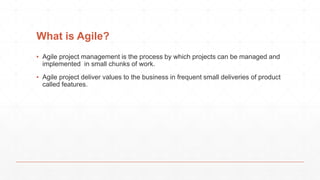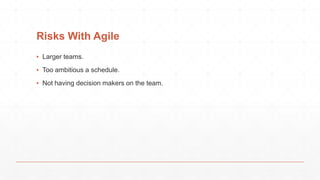Understanding Agile Project Management (APM)
- 1. Agile Agile Project Management (APM)
- 2. Content ▪ What Is Agile? ▪ Characteristics of Successful Agile Projects. ▪ Agile Lifecycle (Phases). ▪ Envision Phase. ▪ Speculate Phase. ▪ Explore Phase. ▪ Adapt Phase. ▪ Close Phase. ▪ Risks With Agile.
- 3. What is Agile? ▪ Agile project management is the process by which projects can be managed and implemented in small chunks of work. ▪ Agile project deliver values to the business in frequent small deliveries of product called features.
- 4. What is Agile? “With Agile project items is created via a small logical chunks of work called iterations or sprints.”
- 5. Suitable Agile Projects ▪ IT and non-IT. ▪ Facility moves. ▪ Company reorganization. ▪ Changing business processes. ▪ Projects with short production and implementation times.
- 6. Characteristics of Successful Agile Projects ▪ 4-12 week sprints. ▪ Face to face. ▪ Co-location. ▪ Sponsor committed to Agile. ▪ Requirements change anticipated and accommodated.
- 7. Other Items Required ▪ Vision . ▪ Universally understood project lifecycle. ▪ Requirements must be understood. ▪ Shared and managed schedule. ▪ Dedicated team. ▪ Communication is critical.
- 8. Agile Lifecycle (Phases) ▪ Envision. ▪ Speculate. ▪ Explore. ▪ Adapt. ▪ Close.
- 9. The Envision Phase “Envision phase provides the foundation for the project”. ▪ Determine what you will build. ▪ Determine team members. ▪ Establish team values and norms.
- 10. Envision Phase Deliverables ▪ Project charter. ▪ Defined stakeholders. ▪ Collaboration tools. ▪ Team norms.
- 11. Envision Phase Outputs ▪ Documented project charter. ▪ Defined stakeholders. ▪ Collaboration tools setup. ▪ Team norms.
- 12. The Project Charter ▪ Boundaries for the project. ▪ Product Vision. ▪ Target customer, benefits. ▪ Project manager. ▪ Level of authority given to the project manager.
- 13. Collaboration Tools ▪ Easy communication. ▪ Track and report status. ▪ Facilitate joint feature development. ▪ Push information out to team.
- 14. Examples of Collaboration Tools ▪ Size of the project. ▪ Number of stakeholders and amount of collaboration desired.
- 15. Team Norms ▪ How they will work together. ▪ Where they will work.
- 16. Example of Team Norms ▪ Actively listen. ▪ Attack the problem, not the person. ▪ Seek to understand. ▪ Focus on the current sprint. ▪ If you see a problem, say something. ▪ Engage in daily meetings.
- 17. Example of Team Norms ▪ Solve problems with your peer. ▪ Email is not to solve problems. ▪ No texting during meetings. ▪ Be respectful. ▪ Have the project as your first priority. ▪ Share and respect roles and responsibilities.
- 18. The Speculate Phase “The primary purpose of the speculate phase is for the business and technical teams to identify the features for this iteration”. ▪ Feature-based delivery plan. ▪ Estimates. ▪ Risks to manage.
- 19. The Speculate Phase Deliverables ▪ Requirements. ▪ Features to be developed. ▪ Effort estimates. ▪ Risks by feature.
- 20. Speculate Phase Considerations ▪ News features. ▪ Features from the backlog list. ▪ Features not completed from the prior sprint.
- 21. Features ▪ A feature is a small client valued function expressed in a form (action & result) that allows the user to satisfy a business objective or need. ▪ A feature is similar to requirements but instead focuses on a specific business need.
- 22. Examples of Features ▪ Calculate tax for supplies ordered. ▪ Display the name and address of buyer. ▪ Display the shipping name and address on the invoice. ▪ Enroll a student in a course. ▪ Track course completions.
- 23. With a Complete Set of Features ▪ Review and prioritize. ▪ Ask Questions. ▪ Add features. ▪ Discuss features for a future project.
- 24. Using Agreed Features ▪ Estimate the work effort. ▪ Verify estimates are accurate. ▪ Develop the Iteration, Milestone and Release Plan.
- 25. Iteration, Milestone, and Release Plan ▪ Lists all features. ▪ When features will be completed. ▪ When features will be implemented.
- 26. The Explore Phase “This Phase is about…”. ▪ Collaboration. ▪ Daily stand-up meetings. ▪ Peer reviews. ▪ Daily interactions. ▪ Testing.
- 27. The Stand-Up Meeting “It should be around 15 minutes long 30 minutes max, each team member shares:” ▪ What was achieved yesterday. ▪ What is planned for today. ▪ Any help needed to progress work. ▪ Not for resolving issues.
- 28. Project Manager at Stand-Ups ▪ An observer. ▪ Watch for issues. ▪ Remove roadblocks. ▪ Ensure risks are decreasing over time. ▪ Listen carefully. ▪ Protect and enhance productivity. ▪ Handle organizational distractions.
- 29. Project Manager's Control Mechanism ▪ Track progress. ▪ Use a feature board. ▪ Find out why any features are late. ▪ Make adjustments quickly.
- 30. Don't Let Time Get Away ▪ Timekeeping is essential. ▪ Maintain the sprint schedule. ▪ End the phase on time.
- 31. The Adapt Phase ▪ Review what has been delivered. ▪ Compare to your plan. ▪ Discuss what is and is not working. ▪ Agree to changes. ▪ Review the product with customer. ▪ Confirm if working as expected. ▪ Validate business benefits.
- 32. The Adapt Phase Activities ▪ Final review of features. ▪ Reflection on performance. ▪ Capture lessons. ▪ Adjust future sprint plans.
- 33. Typical Adjustments ▪ Adding or removing features. ▪ Adjusting estimates. ▪ Reprioritizing estimates. ▪ Modifying the daily stand-up agenda. ▪ Changing team members. ▪ Updating the risk register. ▪ Modifying processes. ▪ Adding processes, if essential.
- 34. Close Phase ▪ Ensure all deliverables are completed. ▪ Finalize lessons learned.
- 35. Close Phase Activities ▪ Ensuring vendors are paid and payments received. ▪ Reconciling financials. ▪ Redeploy people to other projects or work activities. ▪ Communicating the overall project results. ▪ Ensure business benefits are monitored and achieved.
- 36. Risks With Agile ▪ Larger teams. ▪ Too ambitious a schedule. ▪ Not having decision makers on the team.




































